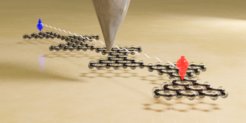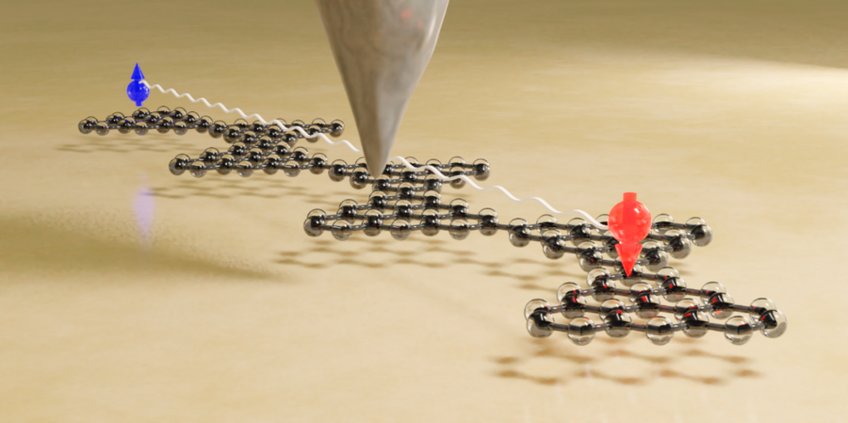Observation of fractional edge excitations in nanographene spin chains
Recently, researchers from the group of Prof. Xinliang Feng (TU Dresden, MPI Halle, Germany) in collaboration with the scientists from Switzerland, Portugal and Spain have succeeded in building carbon-based quantum spin chains, where they captured the emergence of one of the cornerstone models of quantum magnetism first proposed by the 2016 Nobel laureate F. D. M. Haldane in 1983. Published in the journal Nature, the results could have widespread implications in the understanding of low-dimensional quantum magnetism and may contribute toward the emerging field of quantum computation.
We are all used to the idea that simpler units in nature interact to form complex structures. Take for example the hierarchy of life, where atoms combine to form molecules, molecules combine to form cells, cells combine to form tissues, and so on, ultimately leading to the formation of complex organisms such as humans. However, in the quantum world this process may play in reverse, where interactions between two complex objects leads to the emergence of simpler species.

Quantum magic: sawing quantum magnets in half
All elementary particles have a ‘spin’, a fundamental property that governs their interaction with magnetic fields. Spins are quantized, which means they can only assume discrete values. Electrons have the smallest possible spin that can take two discrete values while the next simplest systems are those whose spin takes three discrete values – these are dubbed spin-½ and spin-1, respectively. In the 1980s, it was predicted that a one-dimensional chain of interacting spin-1 units should be ‘fractionalized’, such that the terminal units of the chain behave like spin-½ objects. Therefore, much like magicians who seem to saw a person in two halves and put them apart, quantum correlations in the chain divide a spin-1 in two spin-½ entities.
One dimensional magnetic chains assembled from molecules
Testing this prediction in a laboratory has been challenging for various reasons, chief among being that conventional materials are not one-dimensional. While indirect evidence of spin fractionalization has been seen in crystals of organometallic chains containing transition metal ions, a direct observation of the phenomenon has remained elusive.
![Left: Overview STM of a sample containing triangulene quantum spin chains, where chains containing between two to seven triangulene units are highlighted.Right: High-resolution STM of a ten unit-long spin chain. The chemical structure of [3]triangulene is shown in the inset, where the blue arrows denote a spin-1 interaction between the unpaired electrons.](/590920/original-1635410889.jpg?t=eyJ3aWR0aCI6MjQ2LCJvYmpfaWQiOjU5MDkyMH0%3D--4227b584413c9ecfa7b36654d94a190b31428739)
Right: High-resolution STM of a ten unit-long spin chain. The chemical structure of [3]triangulene is shown in the inset, where the blue arrows denote a spin-1 interaction between the unpaired electrons.
Now, an international team of researchers has found a remarkable route to accomplish this feat. The team composed of organic chemists and local probe scientists fabricated chains of a [3]triangulene with spin 1. Using a scanning tunneling microscope (STM) the Empa-team then probed magnetic excitations of these chains on a gold surface. They found that beyond a certain length, the terminal triangulene units of the chains exhibited Kondo resonances – which are a characteristic spectroscopic fingerprint of spin-½ quantum objects in contact with a metal surface, as also evidenced by theoreticians.
Left: Overview STM of a sample containing triangulene quantum spin chains, where chains containing between two to seven triangulene units are highlighted. Right: High-resolution STM of a ten unit-long spin chain. The chemical structure of [3]triangulene is shown in the inset, where the blue arrows denote a spin-1 interaction between the unpaired electrons.
From chains to networks - and to quantum computers?
The researchers are convinced that such directly accessible molecular systems, which exhibit strongly correlated behavior of electrons, should become a fertile playground for testing new theoretical concepts. After exploring linear spin chains, the scientists will proceed to researching two-dimensional networks of quantum magnets. Such spin networks could possibly be used for quantum computing.
Reference: Shantanu Mishra, Gonçalo Catarina, Fupeng Wu, Ricardo Ortiz, David Jacob, Kristjan Eimre, Ji Ma, Carlo A. Pignedoli, Xinliang Feng*, Pascal Ruffieux*, Joaquín Fernández-Rossier* and Roman Fasel “Observation of fractional edge excitations in nanographene spin chains” Nature, 2021, doi: 10.1038/s41586-021-03842-3
Acknowledgments: This work was supported by the Swiss National Science Foundation (grant numbers 200020-182015 and IZLCZ2-170184), the NCCR MARVEL funded by the Swiss National Science Foundation (grant number 51NF40-182892), the European Union’s Horizon 2020 research and innovation program (grant number 881603, Graphene Flagship Core 3), the Office of Naval Research (N00014-18-1-2708), ERC Consolidator grant (T2DCP, grant number 819698), the German Research Foundation within the Cluster of Excellence Center for Advancing Electronics Dresden (cfaed) and EnhanceNano (grant number 391979941), the Basque Government (Grant No. IT1249-19), the Generalitat Valenciana (Prometeo2017/139), the Spanish Government (Grant PID2019-109539GB-C41), and the Portuguese FCT (grant number SFRH/BD/138806/2018). Computational support from the Swiss Supercomputing Center (CSCS) under project ID s904 is gratefully acknowledged.
Text: TU Dresden / Sabine Strecker

![Left: Overview STM of a sample containing triangulene quantum spin chains, where chains containing between two to seven triangulene units are highlighted.Right: High-resolution STM of a ten unit-long spin chain. The chemical structure of [3]triangulene is shown in the inset, where the blue arrows denote a spin-1 interaction between the unpaired electrons. Left: Overview STM of a sample containing triangulene quantum spin chains, where chains containing between two to seven triangulene units are highlighted.Right: High-resolution STM of a ten unit-long spin chain. The chemical structure of [3]triangulene is shown in the inset, where the blue arrows denote a spin-1 interaction between the unpaired electrons.](/590920/original-1635410889.jpg?t=eyJ3aWR0aCI6MzQxLCJmaWxlX2V4dGVuc2lvbiI6ImpwZyIsIm9ial9pZCI6NTkwOTIwfQ%3D%3D--5412bf21c73c6ca806093cee0816a676575ba33a)











